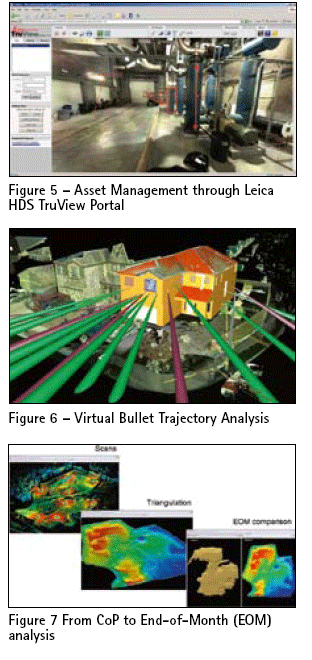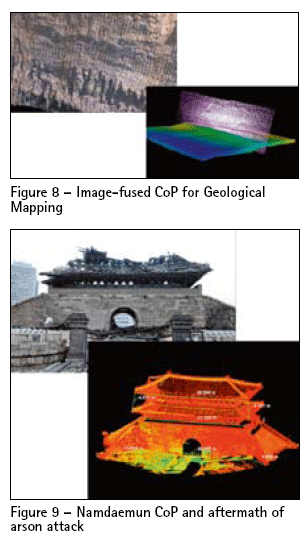| Mycoordinates | |
High-definition surveying
|
||||||||||||||||||
|
The term Terrestrial 3D Laser Scanning scan is commonly referred to the process of collecting large number of data points through high performance hardware devices (3D Laser Scanners) delivering raw data outputs in the form of point clouds or cloud of points (CoP). The concept of High-Definition surveying, on the other hand, extends the capabilities of 3D Laser Scanners by providing effective field and office workflow solutions in combination with data mining and visualisations (Frei, Kung, Bukowski, 2004) tools that can handle multi-billion data points seamlessly and effectively turn the vast amounts of data points into useful deliverables, including: · 3D As-Built Models Two main streams of technologies are offered by manufacturers of 3D Laser Scanners today, namely Time-of-Flightbased (TOF) and Phase-based technologies. TOF-based systems utilise high-speed timing electronics to measure the time difference of a laser pulse to reach a target and return, effectively giving a range measurement and is done at a rate of typically 50,000 per second. TOF-based systems are suited for longer range (e.g. 700m) applications and also deliver higher accuracies over range than its phase-based counterparts. Phase-based techniques, on the other hand, measure the phase difference and the wavelength of constant waves projected at varying lengths against the reference signal stored in the hardware. This technique generally produces higher data collection rates and higher accuracies at shorter range than its TOF counterpart. The last aspect of HDS lies in the ability to improve field data collection workflows through the adoption of traditional and robust field collection methods (e.g. resection and traverse workflows) as well as mobile methods including “Stop and Go” scanning as well as Kinematic Scanning through the use of additional hardware equipment and sensors. BackgroundTraditional survey instrumentation, such as Total Stations provide surveyors with the ability to capture roughly 400- 500 useful points in a day on a project. This is generally due to the fact that a large portion of their time is used in walking the site and the measurement process is manual and relatively slow. HDS, on the other hand, delivers much higher field efficiencies than conventional methods, at better quality, completeness, safety and accuracy. This has led to a steady increase in the adoption of HDS methods by users from our highly diverse industry across the Asia region. ApplicationsCivil and Building Survey In the areas of Civil and Building Survey, HDS is commonly deployed to create as-built drawings of various types for a variety of structures. In Singapore, we have seen a number of airports laser scanned in the shutdown and low usage period over night, in pitch dark conditions (where laser scanners still perform equally well) for quicker final map outputs with complete information (Figure 1). The completeness of the data eliminates the need for site go-backs which is commonly one of the more expensive costs that one has to manage in a survey operation. In addition to general topographic mapping of sites, especially for critical, difficult to access, busy or unsafe areas, HDS provides a quick and safe way to capture complex environment as seen in the cases of the survey and mapping of the Victoria Memorial Hall with its intricate architectural details (Figure 2), conventional methods would have taken much longer time and deliver possibly sub-par accuracies due to the higher possibility of human error in the largely manual data collection process. 3D City Modelling 3D City Modelling, for urban planning and redevelopment, homeland security or even mobile and electronic commerce is gaining growing attention from both end users as well as service providers. A recent exciting application in Korea sees the development of 3D City Models for a better on-line immersive experience in the virtual world for gaming as well as other potential applications. 3D City Models are currently commonly developed using Aerial LiDAR technologies but HDS provides an effective way to fuse the “top-down” and “oblique” view of the world for a true 3D experience, both inside and outside, above and below a structure. Plant Engineering Plant Engineering remains one of the largest application areas, especially in South East Asia, for the technology. Service providers, who are traditionally not surveying and mapping firms, have readily adopted HDS technology to provide the as-built survey and modelling service for plants of all types (from Oil and Gas to Food Processing) to help in both the design and retrofit process since generally, as-built data of existing facilities is not correct (Figure 3) or in some cases, not even available. Not only does HDS provide these users with an ability to create final asbuilt models for design verification or retrofit purpose, HDS also provides designers with an ability to perform virtual fit-up and clash analysis (Figure 4) and reduce the need of rework by bringing the plant to their desktop. Asset Management Another growing application of HDS is in the area of Asset Management. Users from a defence establishment in the region have identified the ability of HDS to quickly capture and archive asbuild conditions and publish in the form of web portals (Figure 5). This capability allows Asset Managers to access sites located all over the world through a web-based interface from their desktop and perform collaboration, mark-up/ tagging, measurement and communication over the environment to better perform the task of asset management. Forensic and Homeland Security The objectivity of 3D Laser Scanner lends itself very well towards the applications of Crime Scene Mapping. Numerous Police agencies in the region have adopted the technology for areas such as: · Crime Scene Investigation HDS is commonly used by law enforcement agencies to perform once difficult tasks, such Virtual Bullet Trajectory Analysis (Figure 6) and Crime/Accident Scene Reconstruction. An animated version of the crime is much better than a picture and even better than words in front of a jury and the visual, accurate, objective and completeness value of HDS makes the technology now a fundamental tool, and heavily used by, for example, the Australian Police agencies in the region. As an example closer to home, HDS technology was recently put to use to support post-blast analysis at the Jakarta bomb sites (July 2009) near the JW Marriott hotel. Volumetric and Mining Survey The mining industry is under constant pressure to meet production demands and manage operational efficiency and safety standards. Stockpile surveys are frequently required to reconcile quantities, settle contractual obligations and also to manage operations (Figure 7). The generally and relatively less accurate, efficient, safe and complete method of conventional survey is rapidly replaced by 3D Laser Scanning technology for rapid route to deliverables. In addition to volumetric surveys, scanning technology is used to monitor the stability of various types of manmade and natural structures and sites to maximize the efficiency and safety of mining operations. Image-fused point cloud data is also routinely supplied for geological mapping purpose (Figure 8) to help determine dips/strike angles and also coal seams. The applications of HDS in the mining industry in Indonesia are the most common in the Asia region. Heritage and Archaeology The last application segment presented in this paper covers the area of heritage and conservation. The best example to highlight the application of HDS in this area lies at the home of the venue of this Congress and is at the Borobudur World Heritage Site (UNESCO Jakarta Office, 2005). The Borobudur Heritage Conservation Institute has actively documented the Borobudur temple and site environment and structures and created a highly accurate 3D image and geometrical database of the World Heritage Site for both conservation as well as reconstruction efforts. HDS provides the ability to scan at 1mm resolution, capturing highly intricate details accurately and without disturbing the site, thus preserving the possibly dilapidated structures for preservation and also reconstruction using the scanned standing structures as models. South Korea stands out in the region in the adoption of this technology where we see both a commercial and government industry strongly supporting the conservation of historical relics and protecting our delicate heritage. It was only recently that the value of such surveys was realised when, due to an unfortunate but deliberate attack, Korea’s number one heritage site – the South Gate or “Namdaemun” was destroyed by an arsonist (Figure 9). Fortunately HDS technology was deployed several years ago and a complete 3D model of the structure was available and is now used in the reconstruction efforts. Observation, outlook and conclusionObservation and Outlook ConclusionThe technology of HDS, which combines hardware, software and visualisation technologies, is delivering benefits to a large spectrum of users in a highly diverse industry. The Asia region, in particular has taken encouragingly increasing advantage of the technology, particularly in the Plant Engineering segment. Further education is needed to increase the awareness of the availability and true value of such technologies to owner/ operators and “final end users” alike to help reap the full benefit and provide the maximum value of the technology to the society and industry at large. References● Frei, E., Kung, J. Bukowski, R., 2004. High-Definition Surveying (HDS): A new era in reality capture, Proceedings of the ISPRS working group VIII/2: “Laser-Scanners for Forest and Landscape Assessment”, pp. 262-271. |
||||||||||||||||||
|
||||||||||||||||||
|

















 (No Ratings Yet)
(No Ratings Yet)





Leave your response!